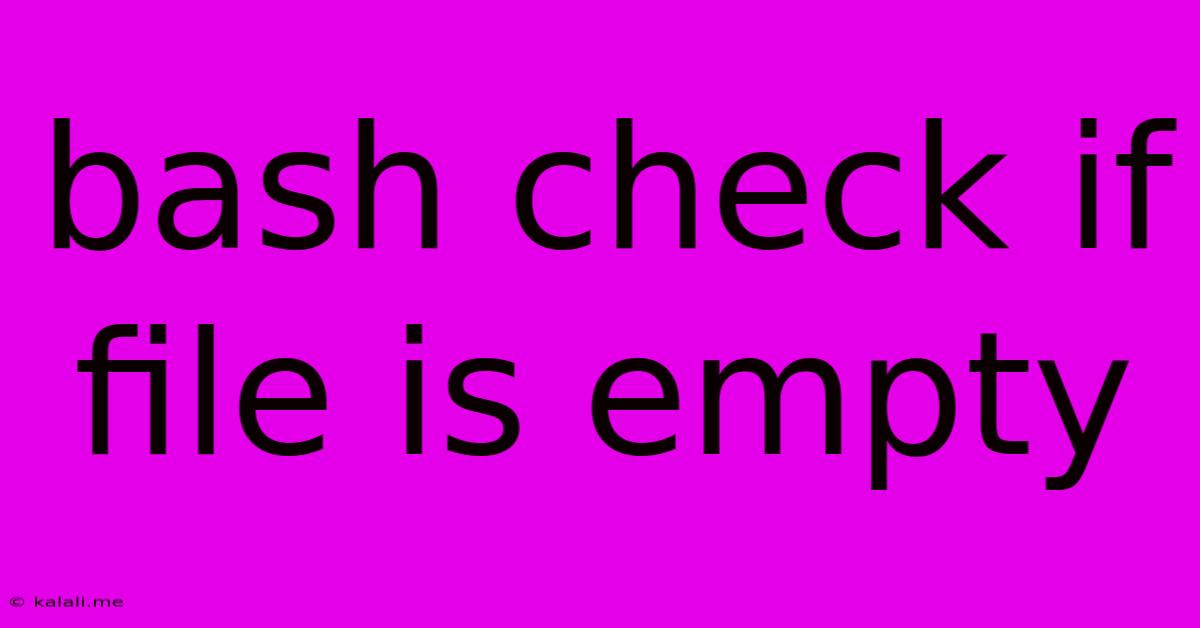Bash Check If File Is Empty
Kalali
Jun 06, 2025 · 3 min read

Table of Contents
Bash Check if File is Empty: Several Methods Explained
This guide explores multiple ways to check if a file is empty in Bash scripting, catering to different scenarios and skill levels. Knowing how to efficiently determine file emptiness is crucial for robust and reliable scripts. Whether you're a beginner or an experienced Bash user, this article offers clear explanations and practical examples.
Why Check for Empty Files?
Checking for empty files is a common task in scripting. It's frequently used to prevent errors, improve script efficiency, and implement conditional logic. For example, you might want to avoid processing a file if it contains no data, or trigger a different action based on whether a log file is empty.
Methods to Check for Empty Files in Bash
Here are several approaches, ranging from simple to more sophisticated techniques:
1. Using -s File Test Operator
This is the simplest and most efficient method for checking file emptiness. The -s operator tests if a file exists and has a size greater than zero.
if [ -s "my_file.txt" ]; then
echo "File is not empty"
else
echo "File is empty or does not exist"
fi
This code snippet directly checks the file size. If the file exists and its size is greater than zero, the -s operator returns true; otherwise, it returns false. This is the recommended approach for its clarity and efficiency.
2. Using wc -c Command
The wc -c command counts the number of bytes in a file. We can use this to indirectly check for emptiness.
file_size=$(wc -c < "my_file.txt")
if [ "$file_size" -gt 0 ]; then
echo "File is not empty"
else
echo "File is empty or does not exist"
fi
This method first captures the byte count and then compares it to zero. While functional, it's less efficient than the -s operator because it involves an extra process.
3. Using stat Command
The stat command provides detailed file information, including the size. We can extract the size and check if it's zero.
size=$(stat -c%s "my_file.txt")
if [ "$size" -gt 0 ]; then
echo "File is not empty"
else
echo "File is empty or does not exist"
fi
Similar to wc -c, this approach is less direct and efficient than the -s operator.
4. Handling Potential Errors: Checking File Existence
All the above methods implicitly check for file existence. However, for enhanced robustness, explicitly check if the file exists using the -f operator before checking for emptiness:
if [ -f "my_file.txt" ]; then
if [ -s "my_file.txt" ]; then
echo "File exists and is not empty"
else
echo "File exists but is empty"
fi
else
echo "File does not exist"
fi
This refined approach explicitly handles the case where the file might not exist, preventing potential errors.
Choosing the Right Method
For most cases, the -s operator is the most efficient and recommended method. It's concise, clear, and directly addresses the problem. The other methods are provided for completeness and to illustrate alternative approaches. Remember to choose the method that best suits your needs and coding style, prioritizing clarity and efficiency. Always consider incorporating error handling to create more robust and reliable scripts.
Latest Posts
Latest Posts
-
How To Change Light Bulb Ceiling Fan
Jun 07, 2025
-
3 Places In Acts Where Conflict Occurred
Jun 07, 2025
-
1 2 Or 3 4 Water Supply Line
Jun 07, 2025
-
How Long Is A Rotation In Sstar Wars
Jun 07, 2025
-
How Do You Cut Granite Countertops
Jun 07, 2025
Related Post
Thank you for visiting our website which covers about Bash Check If File Is Empty . We hope the information provided has been useful to you. Feel free to contact us if you have any questions or need further assistance. See you next time and don't miss to bookmark.